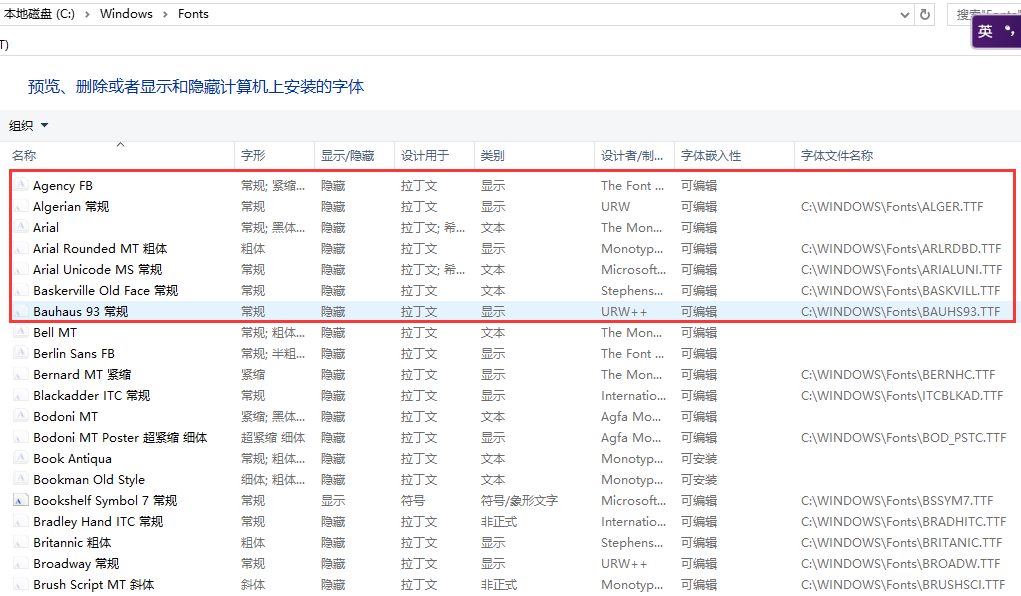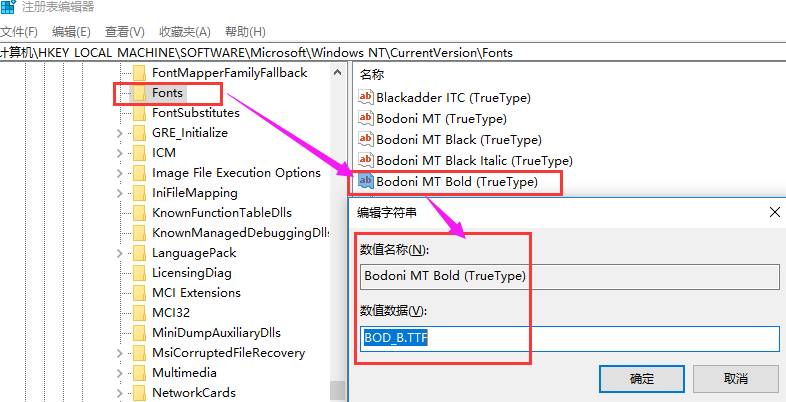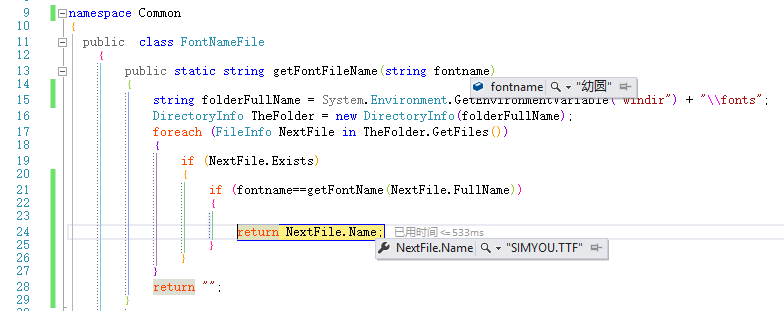C#根據字體名通過註冊表獲取該字體文件路徑(win10)
阿新 • • 發佈:2017-05-18
cat mic 約束 lec 運行 window mac war 控件
方法一:
直接先上源碼:
private System.Collections.Generic.SortedDictionary<string, string> ReadFontInformation()
{
var dictionary = new System.Collections.Generic.SortedDictionary<string, string>();
Microsoft.Win32.RegistryKey localMachineKey = Microsoft.Win32.Registry.LocalMachine;
// 打開註冊表
Microsoft.Win32.RegistryKey localMachineKeySub = localMachineKey.OpenSubKey("SOFTWARE\\Microsoft\\Windows NT\\CurrentVersion\\Fonts", false);
//獲取字體名
string[] mynames = localMachineKeySub.GetValueNames();
foreach (string name in mynames)
{
//獲取字體的文件名
string myvalue = localMachineKeySub.GetValue(name).ToString();
if (myvalue.Substring(myvalue.Length - 4).ToUpper() == ".TTF" && myvalue.Substring(1, 2).ToUpper() != @":\")
{
string val = name.Substring(0, name.Length - 11);
dictionary[val] = myvalue;
}
}
localMachineKeySub.Close();
return dictionary;
}
解決思路:
1. 打開windows/fonts目錄, 右鍵下圖, 勾選字體文件名稱, 發現其實字體文件名稱和顯示的名稱是有區別的


2. 然後去註冊表中看看, win+r→regedit, 定位 LocalMachine \\SOFTWARE\\Microsoft\\Windows NT\\CurrentVersion\\Fonts 可以看到, 對應的鍵值對

3. 既然有思路了, 就開始操作註冊表, 註意, 如果在win7以上的系統中, 將localMachineKey.OpenSubKey("",true)第二個參數設置為true, 在xp下沒有問題, 在win7以上就會報以下錯誤:

4. 解決此錯誤的方法是增加應用程序配置清單文件, 然後做下面的修改, 但是在運行的時候, 會提示要求用管理員權限(提權). 全部代碼和清單文件內容如下:
//[System.Security.Permissions.RegistryPermissionAttribute(System.Security.Permissions.SecurityAction.PermitOnly, Read = @"HKEY_LOCAL_MACHINE\SOFTWARE\Microsoft\Windows NT\CurrentVersion\Fonts")]// 約束代碼僅可讀註冊表
private System.Collections.Generic.SortedDictionary<string, string> ReadFontInformation()
{
var dictionary = new System.Collections.Generic.SortedDictionary<string, string>();
Microsoft.Win32.RegistryKey localMachineKey = Microsoft.Win32.Registry.LocalMachine;
// 打開註冊表
Microsoft.Win32.RegistryKey localMachineKeySub = localMachineKey.OpenSubKey("SOFTWARE\\Microsoft\\Windows NT\\CurrentVersion\\Fonts", false);
//獲取字體名
string[] mynames = localMachineKeySub.GetValueNames();
foreach (string name in mynames)
{
//獲取字體的文件名
string myvalue = localMachineKeySub.GetValue(name).ToString();
if (myvalue.Substring(myvalue.Length - 4).ToUpper() == ".TTF" && myvalue.Substring(1, 2).ToUpper() != @":\")
{
string val = name.Substring(0, name.Length - 11);
dictionary[val] = myvalue;
}
}
localMachineKeySub.Close();
return dictionary;
}
清單文件:

<?xml version="1.0" encoding="utf-8"?>
<assembly manifestVersion="1.0" xmlns="urn:schemas-microsoft-com:asm.v1">
<assemblyIdentity version="1.0.0.0" name="MyApplication.app"/>
<trustInfo xmlns="urn:schemas-microsoft-com:asm.v2">
<security>
<requestedPrivileges xmlns="urn:schemas-microsoft-com:asm.v3">
<!-- UAC 清單選項
如果想要更改 Windows 用戶帳戶控制級別,請使用
以下節點之一替換 requestedExecutionLevel 節點。n
<requestedExecutionLevel level="asInvoker" uiAccess="false" />
<requestedExecutionLevel level="requireAdministrator" uiAccess="false" />
<requestedExecutionLevel level="highestAvailable" uiAccess="false" />
指定 requestedExecutionLevel 元素將禁用文件和註冊表虛擬化。
如果你的應用程序需要此虛擬化來實現向後兼容性,則刪除此
元素。
-->
<requestedExecutionLevel level="requireAdministrator" uiAccess="false" />
</requestedPrivileges>
</security>
</trustInfo>
<compatibility xmlns="urn:schemas-microsoft-com:compatibility.v1">
<application>
<!-- 設計此應用程序與其一起工作且已針對此應用程序進行測試的
Windows 版本的列表。取消評論適當的元素,Windows 將
自動選擇最兼容的環境。 -->
<!-- Windows Vista -->
<!--<supportedOS Id="{e2011457-1546-43c5-a5fe-008deee3d3f0}" />-->
<!-- Windows 7 -->
<!--<supportedOS Id="{35138b9a-5d96-4fbd-8e2d-a2440225f93a}" />-->
<!-- Windows 8 -->
<!--<supportedOS Id="{4a2f28e3-53b9-4441-ba9c-d69d4a4a6e38}" />-->
<!-- Windows 8.1 -->
<!--<supportedOS Id="{1f676c76-80e1-4239-95bb-83d0f6d0da78}" />-->
<!-- Windows 10 -->
<!--<supportedOS Id="{8e0f7a12-bfb3-4fe8-b9a5-48fd50a15a9a}" />-->
</application>
</compatibility>
<!-- 指示該應用程序可以感知 DPI 且 Windows 在 DPI 較高時將不會對其進行
自動縮放。Windows Presentation Foundation (WPF)應用程序自動感知 DPI,無需
選擇加入。選擇加入此設置的 Windows 窗體應用程序(目標設定為 .NET Framework 4.6 )還應
在其 app.config 中將 "EnableWindowsFormsHighDpiAutoResizing" 設置設置為 "true"。-->
<!--
<application xmlns="urn:schemas-microsoft-com:asm.v3">
<windowsSettings>
<dpiAware xmlns="http://schemas.microsoft.com/SMI/2005/WindowsSettings">true</dpiAware>
</windowsSettings>
</application>
-->
<!-- 啟用 Windows 公共控件和對話框的主題(Windows XP 和更高版本) -->
<!--
<dependency>
<dependentAssembly>
<assemblyIdentity
type="win32"
name="Microsoft.Windows.Common-Controls"
version="6.0.0.0"
processorArchitecture="*"
publicKeyToken="6595b64144ccf1df"
language="*"
/>
</dependentAssembly>
</dependency>
-->
</assembly>
方法二:直接拿對應的文件名:
public class FontNameFile
{
public static string getFontFileName(string fontname)
{
string folderFullName = System.Environment.GetEnvironmentVariable("windir") + "\\fonts";
DirectoryInfo TheFolder = new DirectoryInfo(folderFullName);
foreach (FileInfo NextFile in TheFolder.GetFiles())
{
if (NextFile.Exists)
{
if (fontname==getFontName(NextFile.FullName))
{
return NextFile.Name;
}
}
}
return "";
}
private static string getFontName(string fontfilename)
{
PrivateFontCollection pfc = new PrivateFontCollection();
//只要ttf和TTF, 其它的本項目不需要
if (fontfilename.EndsWith(".ttf") || fontfilename.EndsWith(".TTF"))
{
pfc.AddFontFile(fontfilename);
}
if (pfc.Families.Length > 0)
{
return pfc.Families[0].Name;
}
return "";
}
}

C#根據字體名通過註冊表獲取該字體文件路徑(win10)
